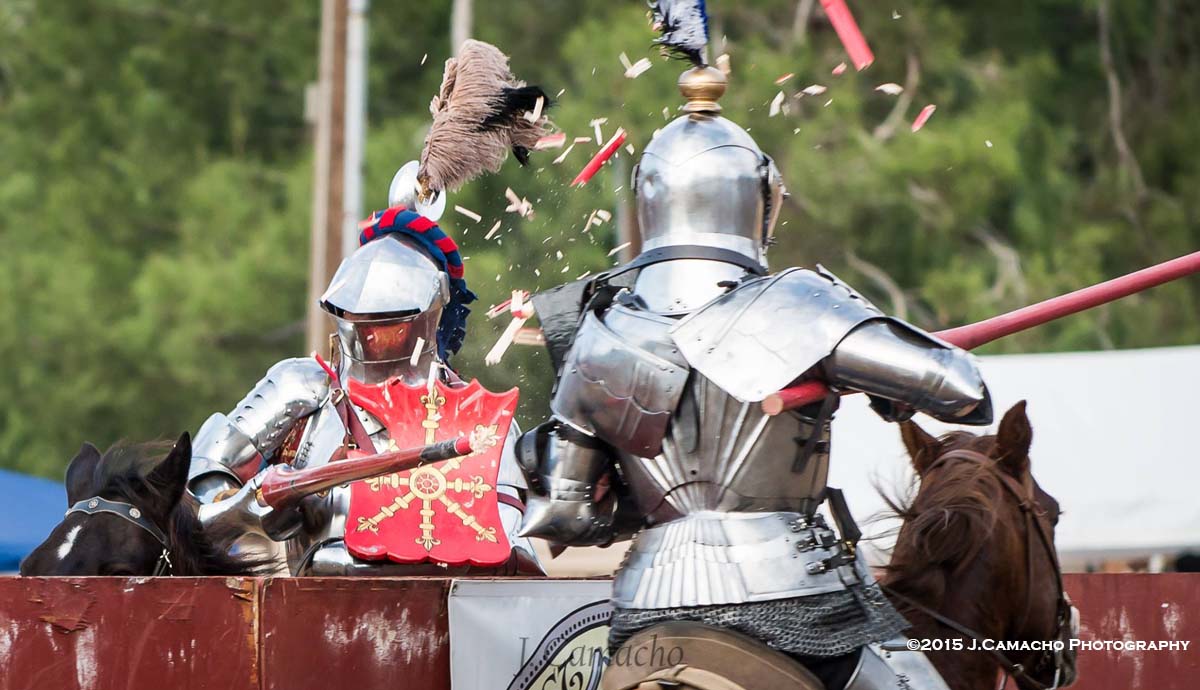 Two knights shatter their lances at the Tournament of the Phoenix 2015. Photo by Javy Camacho.
Two knights shatter their lances at the Tournament of the Phoenix 2015. Photo by Javy Camacho.
Prior to the 15th century, jousters met in an open field and could pass on the right or the left side. Riders and horses were prone to severe injury in the event of a collision. In 1429, at a joust in Arras, France, a rope was hung with cloth to separate the contestants. It was called the tilt or toile. It is likely that the tilt barrier originated in Italy as early jousts with a barrier were referred to as the Italian Course. It did not reach England until the 1430s. Eventually, the cloth barrier evolved into a sturdy wooden wall.
Chapitres d’Armes
The rules for a tournament might be drawn up as much as a year before the event. They were known as chapitres d’armes. In 1466, John Lord Tiptoft, Earl of Worcester, drew up a set of ordinances on behalf of Edward IV to be kept in all manner of jousts of peace in England. The following year, Edward oversaw a tourney at Smithfield. The field measured 370 by 250 feet and ringed by a double palisade.
Courses of Joust
By the middle of the 15th century, three types of jousting courses were recognized in England: the joust of peace, joust of war, and joust at large.
- á Plaisance Jousts of peace utilized tilt barriers to separate the competitors who wore specialized armour and employed lances tipped with coronels. The wore specialized armour The helm was strapped down to the brigandine or cuirass which was fitted with a lance rest. A manifer guarded the left hand and forearm. On the right hand, the rider wore a glove, likely of leather, known as a gaignepain. A poldermitton protected the inner elbow of the right arm. A besagew, or large circular plate, covered the armpit below the laminated right pauldron. A pear-shaped buffer of wood, called a a la Guerre, was attached to the left breast behind the wooden shield, which was covered with square pieces of horn and attached by a cord.
- á Outrance Although jousts of war still utilized tilt barriers to prevent collisions, the course was meant to imitate war. Lances had sharp tips rather than coronels. An armet and wrapper was worn instead of a grand bascinet strapped to the cuirass. Competitors wore field armour with reinforcing plates on the left shoulder, the grandguard, and the left elbow, the pasguard.
- at Large Jousts at large, or at random, were akin to the joust of war but run without a barrier. Once the lances had been used, the combatants would remove their reinforcing plates and turn to blunt swords. The mounted mêlée included a number of riders.
Pas d'Armes
A distinct style of joust a’plaisance where several knights, or tenans, would hold a piece of ground, the pas, against all challengers, called the venans. The was designed to mimick judicial duels of chivalric literature. Shields were hung from a Tree of Chivalry that must be touched to signify a challenge. The event often included not only jousting but also a mounted mêlée a’cheval with clubs or rebated swords and foot combat with pollaxes and daggers.
First 8 photos by Javi Camacho, official photographer of the Tournament of the Phoenix. Remainder by Lonnie Colson.
